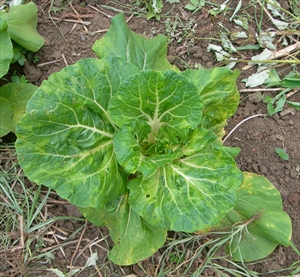Turnip mosaic
Pacific Pests, Pathogens, Weeds & Pesticides - Online edition
Pacific Pests, Pathogens, Weeds & Pesticides
Turnip mosaic (099)
Turnip mosaic virus; the abbreviation is TuMV.
Asia, Africa, North and South America, the Caribbean, Europe, Oceania. It is recorded from Australia, Fiji, French Polynesia, New Zealand, and Solomon Islands.
Many, especially brassicas, including broccoli, cabbage, cauliflower and radish. In Solomon Islands, Chinese cabbage is a host, and in Samoa, brown, Chinese or Indian mustard (Brassica juncea). The virus also infects lettuce and spinach, and some ornamentals, including zinnia and petunia.
A virus causes the disease. The term mosaic describes patterns of dark and light green on the leaves. These light and dark areas often occur either side of major veins (Photo 1).
Turnip mosaic virus is transmitted rapidly in a non-persistent way by several aphid species; this means that the virus does not multiply inside the aphid. As the aphids feed, the virus sticks to the needle-like mouthparts used to pierce and suck out plant sap from a leaf. When the aphid feeds on another leaf, the contaminated mouthparts transfer the virus. The virus is not transmitted in seed.
The transfer of sap from an infected plant to one that is healthy can also spread the virus, but the importance of this method compared to spread by aphids is not known. The absence of aphids on diseased plants is not an indication of their importance. Aphids often alight on a crop, feed and fly on to another plant if the first one is not to their liking.
Turnip mosaic virus is the most important and widespread virus disease affecting brassicas. The affected plants are not suitable for the market.
Look for leaves with distinct light and dark green patches.
Control of Turnip mosaic virus is difficult. The virus has a wide host range, insecticides do not prevent its spread, and there are several strains. Once the plants are infected with Turnip mosaic virus and show symptoms there is no way to make them healthy again, so it is important to prevent infection.
CULTURAL CONTROL
Before planting:
- Avoid planting any of the crops known to be susceptible to Turnip mosaic virus next to older crops of susceptible species; if you do, aphids will quickly move the virus to the new crop.
- In particular, avoid planting down-wind from an infected crop; adult winged aphids can be carried by wind onto the healthy crop.
- Check plants in the nursery for Turnip mosaic virus symptoms; if found remove and destroy them, and check the remainder frequently.
During growth:
- Be careful when handling infected seedling. Be careful, too, when transplanting seedlings to the field. Wash hands frequently with soap and water.
- Continue to check seedlings when transplanted to the field.
- Weed around nurseries and crops in the field as many weeds are hosts of Turnip mosaic virus. Note that some weeds do not show symptoms, but can still be a source of the virus.
After harvest:
- Collect and destroy all remaining plants, leaves and other debris, and burn them.
RESISTANT VARIETIES
Resistant varieties of Chinese cabbage are available, but none are resistant to all of the several strains of Turnip mosaic virus that exist.
CHEMICAL CONTROL
This is not an option. Insecticides take time to kill insects; by the time the aphids are dead, they have already fed and passed on the virus. Sprays of mineral oil (see Fact Sheet no. 56) may be useful to repel aphids.
____________________
When using a pesticide, always wear protective clothing and follow the instructions on the product label, such as dosage, timing of application, and pre-harvest interval. Recommendations will vary with the crop and system of cultivation. Expert advice on the most appropriate pesticide to use should always be sought from local agricultural authorities.
AUTHORS Helen Tsatsia & Grahame Jackson
Information from CABI (2019) Turnip mosaic virus (cabbage A virus mosaic). Invasive Species Compendium. (https://www.cabi.org/ISC/datasheet/54306); and from Turnip mosaic virus (TuMV) (2019) Infonet biovision. (https://infonet-biovision.org/PlantHealth/Pests/Turnip-Mosaic-Virus-TuMV).
Produced with support from the Australian Centre for International Agricultural Research under project PC/2010/090: Strengthening integrated crop management research in the Pacific Islands in support of sustainable intensification of high-value crop production, implemented by the University of Queensland and the Secretariat of the Pacific Community.




